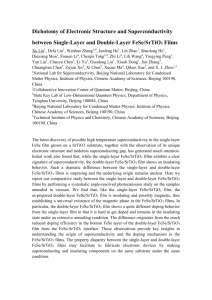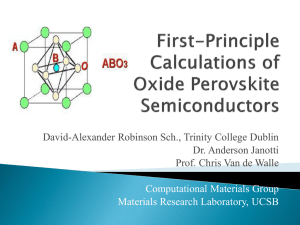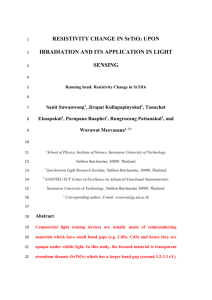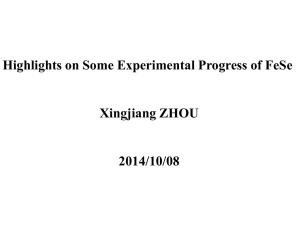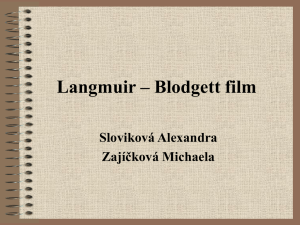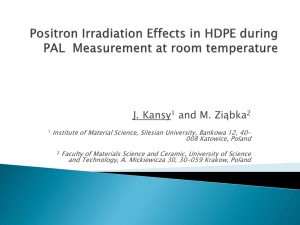WOE19_Keeble - Discovery
advertisement
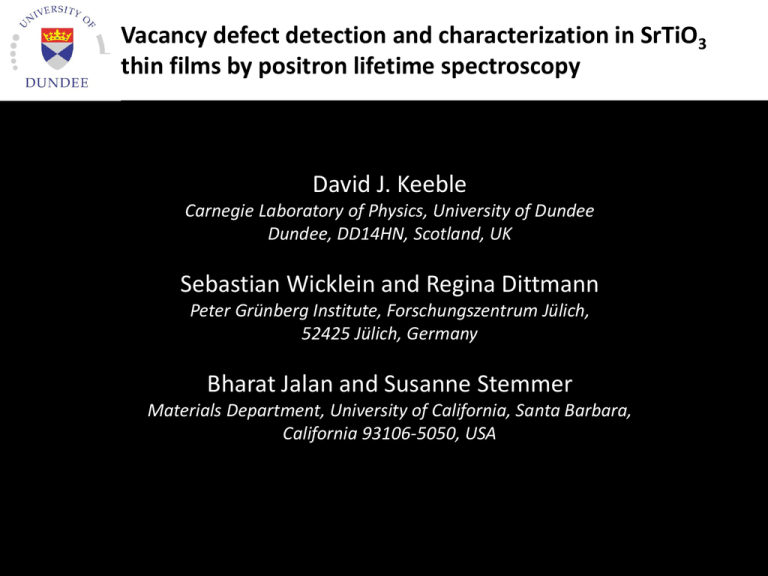
Vacancy defect detection and characterization in SrTiO3 thin films by positron lifetime spectroscopy David J. Keeble Carnegie Laboratory of Physics, University of Dundee Dundee, DD14HN, Scotland, UK Sebastian Wicklein and Regina Dittmann Peter Grünberg Institute, Forschungszentrum Jülich, 52425 Jülich, Germany Bharat Jalan and Susanne Stemmer Materials Department, University of California, Santa Barbara, California 93106-5050, USA Acknowledgements University of Dundee Ross Mackie, Gurmeet Kanda FRMII-NEPOMUC beamline Christoph Hugenschmidt (Technische Universität München, ZWEFRM 11) European Commission Programme RII3-CT-2003-505925 FRMII-NEPOMUC VE-PALS instrument station Werner Egger (Universität Bundeswehr München) TEM L. Jin and C. L. Jia, Peter Grünberg Institute, Research Centre Jülich Non-stoichiometry in thin film SrTiO3 Extreme cation non-stoichiometry Ti – rich Sr – rich B-site Amorphous TiO2 Ruddlesden-Popper SrO layer phases A-site Cation Vacancies? VSr inferred from inhomogenous TEM contrast modulations Ohnishi, et al. J. Appl. Phys. 103, 103703, (2008). VSr inferred from modelling O-K edge ELNES spectra 4 VT i Mizoguchi, et al. Appl. Phys. Lett. 87, 241920 (2005) Tokuda, et al. Appl. Phys. Lett. 99, 033110 (2011). 2 VS r Positrons trap at missing atom defects, open volume defects: antimatter traps at sites of missing matter Positron annihilation spectroscopy (PAS) methods have ppm-level sensitivity PAS methods, combined with DFT, can detect and identify vacancy defects Three PAS methods: here we report positron lifetime spectroscopy measurements Positron Lifetimes Positron lifetime sensitive to electron density 1 r0 c 2 r n r dr E+ EB Negligible e+ trapping V+ positive Good e+ trapping V0 neutral Excellent e+ trapping VO: 2+ V− negative Rydberg states B-site 4− A-site 2− Positron Annihilation Lifetime Spectroscopy Standard Trapping Model (STM) Positron source e+ Thermalization Defect Free Bulk Lattice dn ( t ) dt I 1 1 exp( 1 1 t ) I 2 2 exp( 1 2 t) kD Trapping Defect 1 B Annihilation D B 511 keV Annihilation Radiation 511 keV B U LK 1 B k D I1 1 I 2 2 I2 1 D kD B 1 k D 1 B The bulk positron lifetime is a characteristic of a given material E+ EB Lifetime 1 Value less than bulk lifetime: reduced bulk lifetime Lifetime 2 ‘fixed’ at the defect value Positron Annihilation Lifetime Spectroscopy Two Defect – STM Positron source e+ Thermalization Defect concentration [D] k D D Defect Free Bulk Lattice kD1 D Defect specific trapping coefficient What if the concentration of one/both vacancy is ‘very’ large? 1 B D1 D2 Annihilation Annihilation Radiation 2 B k1 k 2 Reduced bulk Defect 2 Defect 1 1 I1 1 ( I 2 I 3 ) kD2 Trapping I2 1 3 D1 k D1 I3 B D1 k D1 k D 2 I2 I1 D 2 k D2 B D 2 k D1 k D 2 Vacancy 2 Vacancy 1 Saturation trapping occurs: 1 and I1 tend to zero 1 kd2 k d1 d 2 d2 d 1 d1 15 1 D 2 10 s at . Saturation trapping occurs for D 50 ppm B-site A-site 4− 2+ 4 2− 2 2 VT i VS r VO DFT-MIKA Torsti, et al., Phys. Status Solidi B 243, 1016 (2006) Mackie et al. Phys. Rev. B 79 014102 (2009) Keeble et al. Phys. Rev. Lett. 105 226102 (2010) e+ enhancement: AP : Arponen and E. Pajanne, Ann. Phys. (N.Y.) 121, 343 (1979); B. Barbiellini, et al Phys. Rev. B 53, 16201 (1996). (VTi) = 195 ps (bulk) = 152ps (VO) = 161 ps (VTi)relax = 189 ps O ion relaxation: +5.2 % Sr ion relaxation: - 8.4 % (VSr) = 280 ps (VSr) relax = 281 ps Tanaka et al. Phys. Rev. B 68 205213 (2003) O ion relaxation: +3.7 % Ti ion relaxation: - 2.1 % Variable Energy - Positron Annihilation Spectroscopy Start 5 × 108 e+ s-1 at 1 keV NEPOMUC beam line Acceleration 0.5 – 21 keV Stop e+ > 5 x 106 counts / spectrum 0.511 MeV Experiment station Variable Energy – Positron Annihilation Lifetime Spectroscopy (VE-PALS) Variable Energy - Positron Annihilation Lifetime Spectroscopy (VE-PALS) SrTiO3 Film Start Acceleration 0.5 – 21 keV Stop e+ 0.511 MeV SrTiO3 Substrate Un-doped Pulsed Laser Deposited (PLD) SrTiO3 on SrTiO3 Thin Films Sebastian Wicklein and Regina Dittmann (Jülich) HR x-ray diffraction [002] Ti-poor Sr-poor Strontium (Sr) excess Un-doped PLD SrTiO3 on SrTiO3 Thin Films Sr-poor DFT-MIKA (ps) Bulk 152 VO 159 VTi 189 VSr 281 deconvolved e+ states deconvolved e+ states 280 ps 280 ps 183 ps SrTiO3 SrTiO3 Substrate Keeble et. al. Phys. Rev. Lett. 105 226102 (2010) 183 ps Un-doped PLD SrTiO3 on SrTiO3 Thin Films F = 1.50 J cm-2 F = 2.00 J cm-2 ALL films show saturation e+ trapping [VA/B] > 50-100 ppm La-doped Hybrid MBE SrTiO3 on SrTiO3 Thin Films Bharat Jalan and Susanne Stemmer (UCSB) [La] 8 x 1017 cm-3 [La] 3 x 1019 cm-3 La-doped Hybrid MBE SrTiO3 on SrTiO3 Thin Films [La] 8 x 1017 cm-3 Cluster 400 ps VSr = 280 ps VTi = 183 ps 1 < Bulk 155 ps La-doped Hybrid MBE SrTiO3 on SrTiO3 Thin Films [La] 3 x 1019 cm-3 Cluster 400 ps VSr = 280 ps VTi = 183 ps 1 < Bulk 155 ps Hybrid MBE SrTiO3:La - estimate of cation vacancy concentration Reduced bulk lifetime component, < B (155 ps), due to annihilation events with perfect lattice. [La] 8 x 1017 cm-3 k[VSr] = 1.6(2) x 1010 s -1 [La] 3 x 1019 k V IV cm-3 k[VSr] = 5.1(1.5) x 109 Sr s -1 [VSr] 1.7(5) x 1016 cm -3 [VSr] 5.4(6) x 1016 cm -3 Sr 1 1 V Sr RB V Sr V kV Sr V Sr ? No value measured in oxides, estimated values for negative vacancies in Si 2–29× 1015 s ̶ 1 Sr Assume: = 5 x 1015 s -1 E = 4.5 – 8 keV: B(STM) = 157(8) ps E = 4.5 – 7 keV: B(STM) = 154(7) ps Single crystal SrTiO3 [Mackie PRB 2009 79 014102] B(STM) = 155(4) ps Un-doped Pulsed Laser Deposited (PLD) SrTiO3 on SrTiO3 Thin Films Sebastian Wicklein and Regina Dittmann (Jülich) Ti-poor Sr-poor Strontium (Sr) excess Un-doped Pulsed Laser Deposited (PLD) SrTiO3 on SrTiO3 Thin Films Sebastian Wicklein and Regina Dittmann (Jülich) Ti-poor Sr-poor Un-doped PLD SrTiO3 on SrTiO3 Thin Films 2-term fit 1.33 Jcm-2 3-term fit 2-term fit 1.17 Jcm-2 3-term fit Un-doped PLD SrTiO3 on SrTiO3 Thin Films VPbVTi3VO DFT 344 ps Cluster 420 ps Un-doped PLD SrTiO3 on SrTiO3 Thin Films Cluster 420 ps VPbVTi3VO DFT 4 VT i 344 ps Silicon 355 ps 5 vacancies 430 ps 10-14 vacancies Hakala, PRB 57, 7621 (1998) Staab, PRB 65, 115210 (2002) 2 VS r Conclusions SrTiO3 thin films grown by PLD with varying laser fluence (F): Exhibit saturation trapping e+ to both VTi and to VSr defects for all films in the range 1.5 ≤ F ≤ 2.0 Jcm-2 Good agreement between MIKA calculated relaxed structure e+ lifetimes for VTi and to VSr (189 ps and 281 ps) defects and experiment (183 ps and 280 ps) ‘Stoichiometric‘ F = 1.5 Jcm-2 (Dc = 0.0 pm) film: e+ trapping dominated by VTi , likely due to higher defect specific trapping coefficient ‘Sr-poor’ (Dc = 0.2 pm) F = 2.0 Jcm-2 film: e+ trapping dominated by VSr Sr-poor Conclusions SrTiO3 thin films grown by PLD with varying laser fluence (F): Ti-poor Cluster 420 ps 2 VS r 4 VT i 4 VT i Conclusions Hybrid-MBE SrTiO3 shows a reduced bulk lifetime – a fraction of positrons annihilate from perfect lattice. Previous measurements of laser ablated SrTiO3 thin films have observed saturation positron trapping. Near-surface 50 nm contains small vacancy cluster defects. VSr = 280(4) ps The strontium vacancy, VSr , is the dominant cation vacancy The concentrations were estimated to be 5.4(6) x 1016 cm -3 for the [La] 8 x 1017 cm-3 film and 1.7(5) x 1016 cm -3 for the [La] 3 x 1019 cm-3 film. These vacancy concentrations are at least an order of magnitude lower than the La concentrations.
